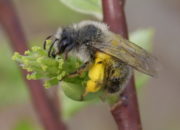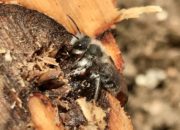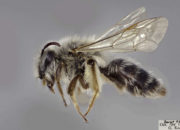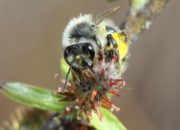This appropriately named species is likely the first species to be active in the spring. Males have been found in late March, even with snow still on the ground. Many of these early records are from sap buckets or wounded maples, which provide sugar before the first flowers bloom. Females are specialists on Willows, and this species disappears by mid-May. Primarily a northern species, most records so far are from east of the Greens.
Identification: Medium-large, both sexes are covered in long, silver hairs, including on the abdomen. Males have a line of dark hairs just inside of the eyes.
Similar Species: Males are similar to Clark’s Mining Bee (Andrena clarkella), another willow specialist that usually has a tinge of orange on the hind legs. Male Carlin’s Mining Bee (Andrena carlini) are also superficially similar with dark hairs inside the eyes.
Known or Suspected Parasites: None known
Global Status: Not Ranked
Vermont Status: Not Ranked
For more information, visit the following links:
Discover Life
Living Atlas Species Page
Distribution: To see the global distribution, check out the iNaturalist account, and toggle the GBIF layer on the map.
 Female Frigid Mining Bee © Michael Tessler
Female Frigid Mining Bee © Michael Tessler
 Male Frigid Mining Bee on a maple stump © Kent McFarland
Male Frigid Mining Bee on a maple stump © Kent McFarland
 Female Frigid Mining Bee
Female Frigid Mining Bee
 Female Frigid Mining Bee © Michael Veit
Female Frigid Mining Bee © Michael Veit






